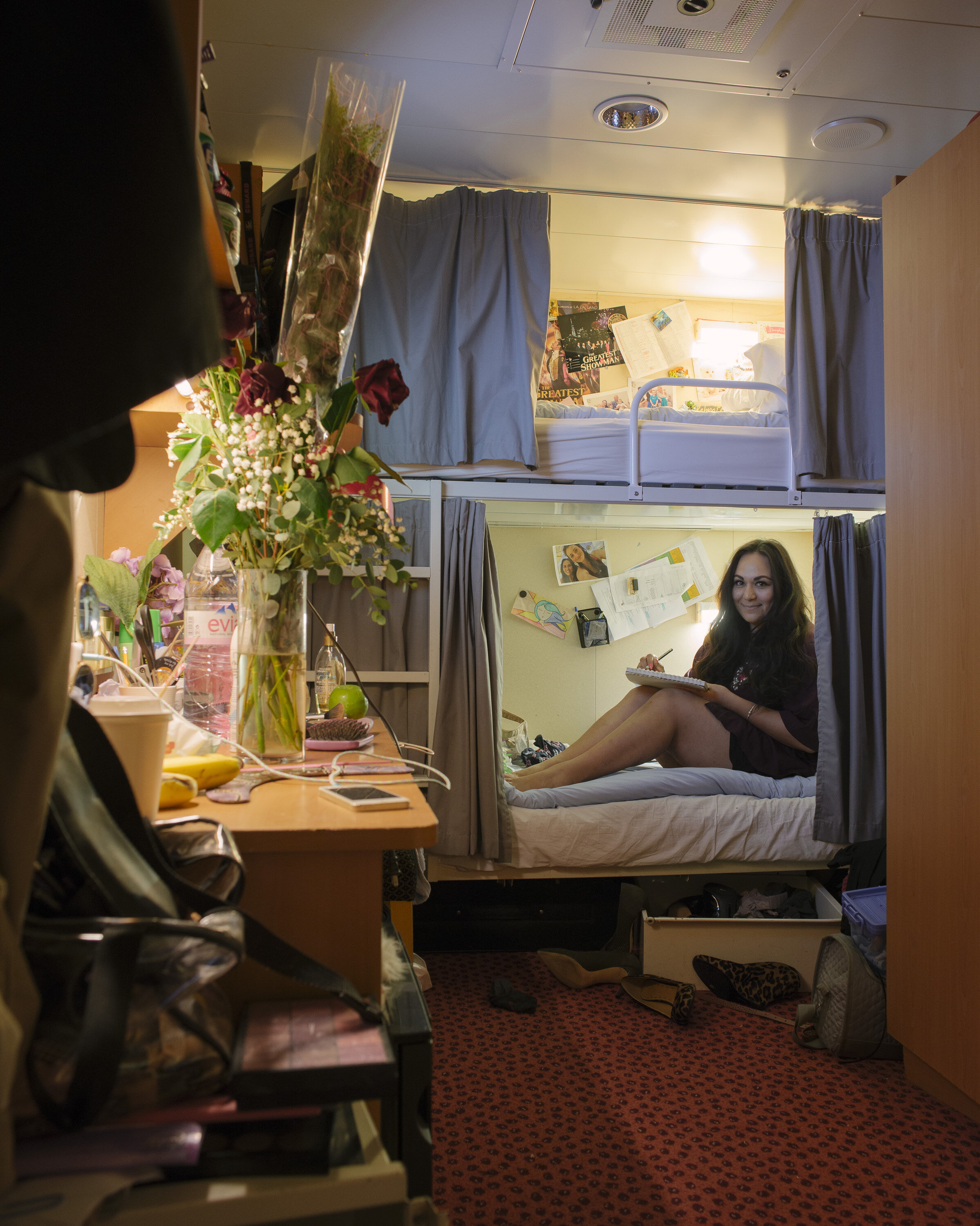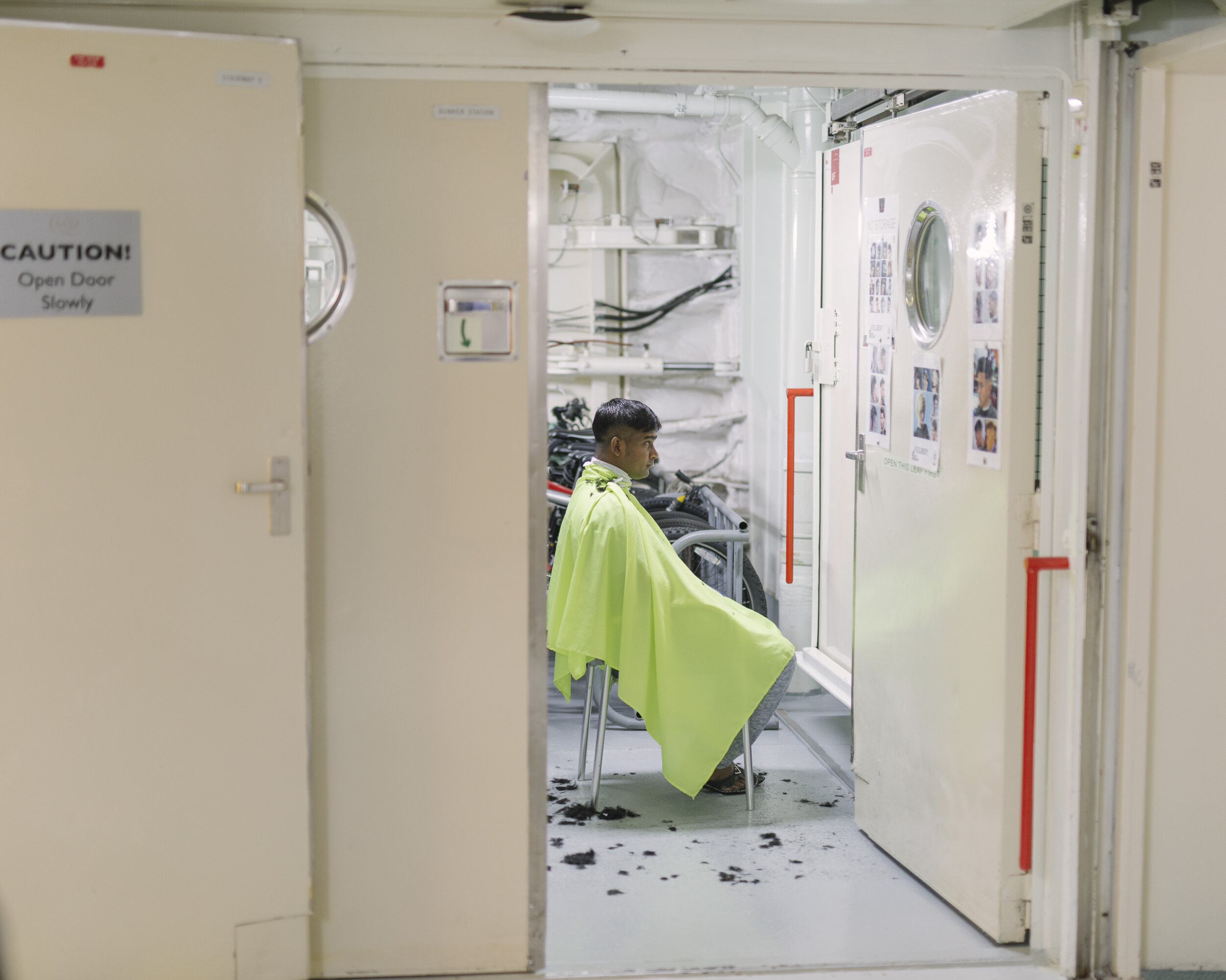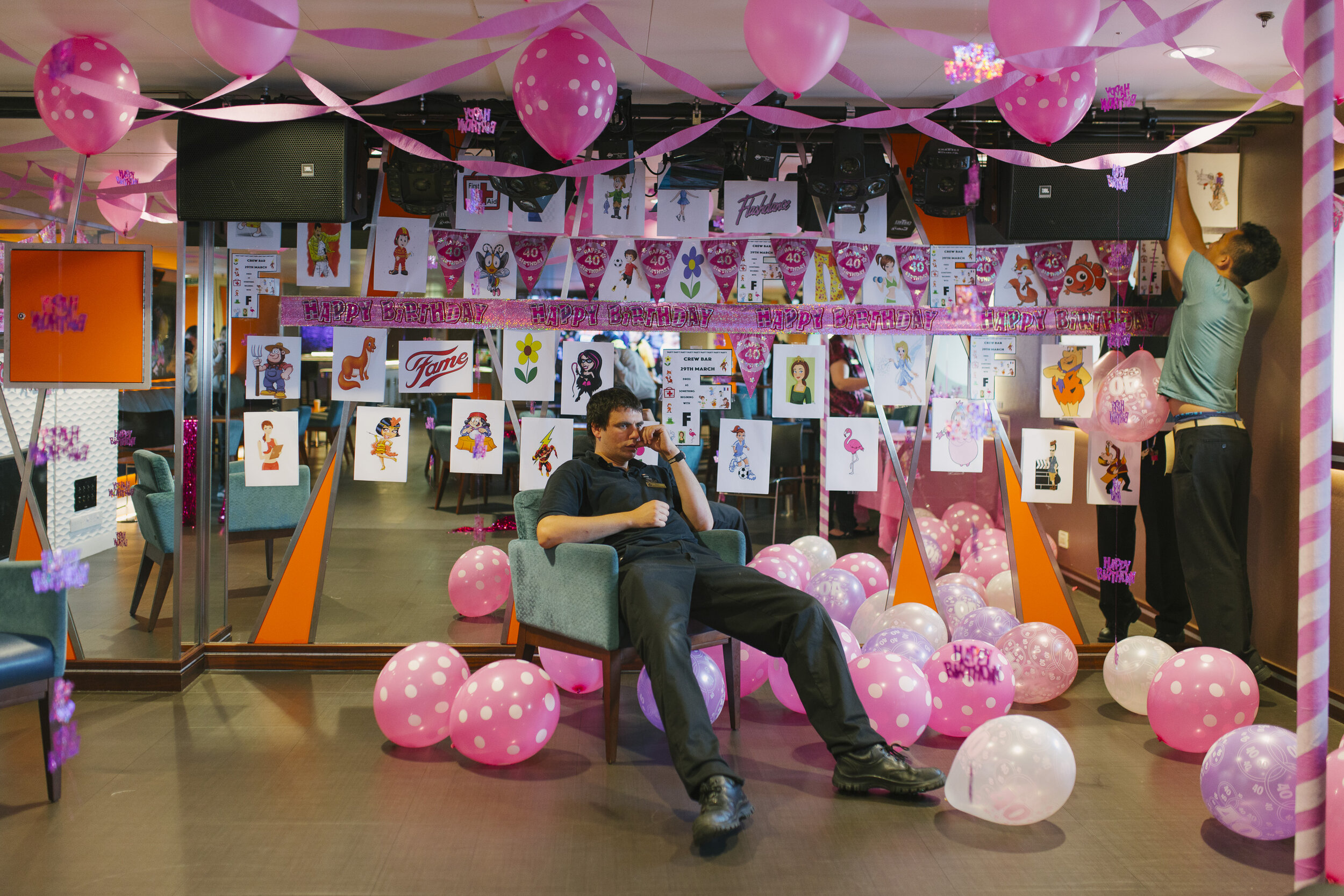Dale Rothenberg - Flags of Convenience
Dale Rothenberg spent four years working as a musician on various cruise lines. His passion for photography combined with his fascination with the cruise industry paved the way for this extensive project and his transition to building a career in photography. Flags of Convenience is a captivating look into the international cruise industry and life on the lower decks.
Flags of Convenience
Interview with Dale Rothenberg
It’s surprisingly quiet to watch a ship weighing 150,000 tonnes depart from a city of seven million people. The port lets out a faint siren as its robotic gangways fold into themselves. The bow thrusters and propellers rumble under the control of the Captain and his officers on the bridge, and the live band on the ship’s aft decks is playing a familiar song. Four decks below them, the deckhands are putting away the mooring lines that fiercely gripped the ship to the dock.
But the city is silent. No one comes to watch the ship leave. Hong Kong’s new cruise terminal, a sterile structure of glass and metal, sits at the end of the old Kai Tak Airport runway. The departure is nothing like the oil paintings depicted; there are no crowds on the dock with handkerchiefs, or tugboats escorting the ship to sea. This scene is romanticized by the old passenger lines like Cunard and Holland America Line, commemorated in the old photographs and paintings littering the hallways of their modern sixteen-story behemoths. Actual on-board museums display curated timelines of ship design, celebrity activity, accidents and sinkings, the pressures of war, and the globalization of the maritime industry.
As long as ships have existed, they have represented the wealth and power of nations. Used as tools of discovery, trade, and war, they have acted as the overreaching hands of countries across bodies of water. The flags hanging off their sterns indicated the interests of the ship’s owners, the laws it followed, and the country it represented.
The exceptions to this rule for various reasons date back thousands of years. Greek sea-traders would operate on behalf of Roman merchants. English shipowners re-registered their ships with the Spanish flag in the sixteenth and seventeenth centuries to gain access to trading in the West Indies. American ships flew Portuguese flags during the War of 1812 to avoid conflicts with the British. And during World War II, the American Government re-registered ships with the neutral Panamanian flag to continue aiding European allies.
The US-Panama relationship is mostly responsible for the modern flagging system. Its roots stem from a handful of significant events in the early twentieth century.
How did you get involved in working on a cruise ship and what made you want to document the working life aboard?
I have a background (and a degree) in piano performance. Some of my older friends had gotten jobs as musicians on ships, and it seemed like a fun and steady gig. My first contract on a ship was four months long in the Caribbean, and a photography project wasn’t on my mind for any of it. I spent my time performing in musicals and cabarets, jazz sets, and dance parties. The entire contract felt like one long party with the entertainment team and the production cast; we rented booze-catamarans in St. Maarten, swam up to the pool bar in Mexico, and had fishermen catch and cook us seafood on the private beach for crew members in Haiti. It wasn’t until my third contract, when I found myself on a ship with very low morale, and the glamour of the daily drinking and partying had worn off, that I realized the potential of a project like this.
How long did you work in the cruise industry? What made you leave?
I worked on ships from 2014 to 2018, though not continuously. I am currently working towards a master’s degree in visual arts, after which I may go back and continue working on this project or a sequel to it. I spent last summer working on land operating bus tours for the ships calling in my city, and I am really interested in exploring more of the port-side operations and local structures of tourism.
I was doing a lot of work in commercial and editorial photography overlapping my time working on ships. I’m incredibly grateful to the studios and photographers I worked with for allowing me the opportunity to disappear for a few months at a time. Working as a freelancer was indispensable to supporting myself while working on this project.
Two Neo-Panamax ships in Nassau, Bahamas. 2016.
Most modern cruise ships carry between two and six thousand passengers, and a third of that in crew. The economies of scale allow them to efficiently operate in Caribbean ports, quickly sailing out of Florida with mostly American tourists. The ships are divided between the hotel department (mostly upper decks) and the deck department (mostly lower decks). The public spaces and hallways have secondary exits leading to hidden crew stairways, all of which lead to the lifeboat deck.
Carnival Corporation (Carnival, Costa, Princess, Holland America, Cunard, P&O, AIDA, Seabourn), Royal Caribbean Cruises Ltd (Royal Caribbean, Celebrity, TUI, Pullmantur, Azamara), and Norwegian Cruise Line Holdings Ltd (Norwegian, Oceania, Regent Seven Seas) control a combined total of nearly eighty percent of the global market share. The ships are built in European shipyards - STX in Finland, Chantiers de l'Atlantique in France, Meyer Werft in Germany, Fincantieri in Italy - and every few years the ships migrate back to Europe for drydock repairs and renovations. They are too large to fit in drydocks in the Americas, but instead are designed around the constraints of the Panama Canal.
The old canal’s limiting dimensions were referred to as Panamax, but a new set of locks opened in 2016 with a much larger carrying capacity, known as the Neo-Panamax specifications. This new addition allows for some of the largest ships to easily transfer from their traditional Caribbean routes to Alaska, Australia, and Asia. Meanwhile, the Neo-Panamax canal is reshaping the shipping industry, with many recently-built Panamax ships being laid up for scrap in favour of larger ones.
What was daily life like on board?
It can be very different on every ship, and it’s very dependent on your job. Many crew members, myself included, have to share a room with a complete stranger. The cabin about the size of my bathroom at home. There is usually no window in the cabin unless you are an officer of rank. Services for crew members, including medical attention and the HR desk, are limited. The food in the mess hall can be hit or miss, depending on the ship, or where the ship is located, or even who is in charge of the budget for food. Sometimes the crew mess is separated, and the staff and officers eat in separate areas. On some ships, staff members have privileges like eating in guest areas, going to the spa, and sitting in guest venues at night ordering from the bar. This varies depending on the cruise line, depending on what the captain allows, and sometimes even depending on your boss. There is no such thing as a weekend on ships, only sea-days and port-days. The amount of work can vary depending on the job, but most people working on ships average over twelve hours a day, every day, for four to ten months at a time.
Maybe I’ve painted a bleak picture, but there are a lot of positive elements of onboard life too. Many cruise lines offer a free spot on tours to crew members, in exchange for a written report on the contents of the tour. Many ships have bicycles available to borrow for crew members to use in port, and offer money exchange services at-cost in many different currencies. There are free exercise classes in the gym after-hours, themed parties once or twice a week, and a lot of the crew has the opportunity to get off the ship every time it’s in port. I won’t argue that this is a responsible method of tourism, but I think it’s interesting that cruise lines are able to use this element of the job as an incentive for employment.
The crew are housed below the passenger decks, and often below sea level. The hallways are narrow and winding, easy to get lost in. If the upper decks resemble a luxury hotel, the crew quarters are a warship. Watertight and splash-tight doors guard the hallways and are remotely closed from the bridge; they can trap you just as easily as they can save you. Instructional videos prove their ability to take off an arm or a leg or a finger.
The main amenities - cafeterias, bars, religious spaces, rec rooms, training facilities - are usually placed along the main crew corridor. On some ships the corridor is called the I-95, on others it’s called Burma Road (when soldiers were crammed into every conceivable space on requisitioned liners, it was so hot that it reminded them of Burma). Life as a crew member is driven by a few social events per week, nightly trips to the crew bar, and a deep realization of the mantra work hard, play harder. A smartphone app designed for crew members counts down the days left of a contract on a digital dial. The app is glanced at during breaks throughout the day, and occasionally before going to sleep at night.
A severe social hierarchy exists within the ship’s company, confining groups by rank and nationality. The younger, lower-ranking officers especially seem to enjoy restricting the amenities of the staff and crew. Each department eats at their own table; the officers’ mess is separate from the staff mess, which is separate from the crew mess. The largest ships have the most cliques, but also provide more entertainment and resources for crew members.
Gergely, musician from Hungary.
How did you make the transition to photography from your day job on the cruise-liners?
It’s really uncomfortable to have a camera out in most crew areas. The place I found most useful was the crew deck, an outside area of the ship reserved for crew members. Usually this is on the bow (which is too windy to be useful for anything while at sea), but it can be in other “unusable" spots like just behind the funnel, where the ship’s exhaust and pollution accumulates. This is a place where crew members can smoke, relax, and feel the expanse of the ocean after a long day of working in an enclosed environment. When the ship is in port, it’s useful for sightseeing. I found it possible to photograph both candid and staged portraits here. Often, I would find it easier to engage with crew members from different backgrounds in this space, because it felt very separate from the work environment.
Galley workers on break. New Zealand, 2018
Can you share some of your most memorable moments (good or bad) from one of your contracts?
I kind of have to mention the eleven hours I spent in early 2016 questioning if we would live or die as our ship, carrying about 4,000 passengers and 2,000 crew members, was tossed about in hurricane-like conditions off the coast of North Carolina. When the storm first struck, I was in a crew area where tables and chairs were shifting from one side of the room to the other. Water was pouring down staircases, the ship was listing continuously at fourteen or fifteen degrees (it feels a lot more severe than it sounds), and we were ordered to stay in our cabins for the duration of the storm. After it was all over, we spent three days limping back up to New York. The incident was covered by national news networks and we could see their coverage from the TV sets in our cabins. The internet, normally an expensive package, was unlocked in all guest areas so that guests could communicate to their families back home that they were safe. But they didn’t make the crew wifi free. I remember groups of forty or fifty crew members would be crammed into the small areas at the bottom of the main guest staircases, trying to get onto the guest wifi.
When we got back to New York, the captain was replaced. When I say New York, I really mean Bayonne, New Jersey. While docked there, work was done externally with divers. We suspected one of the propellors wasn’t working, because we had been traveling at about 8 knots per hour, which is very slow, and the ship’s wake wasn’t coming off of the stern evenly. I don’t know the full extent of the damage caused by the storm, but there were some elements of the top deck including glass barriers and weather monitoring instruments that were repaired or replaced. On the inside of the ship, once everything was cleaned up, it was eerily quiet. There were no guests on board, just background music. I wasn’t allowed off the ship, because I needed to get my passport stamped by an immigration officer, so I spent the days wandering through deserted guest venues with robotic bartenders and animatronic screens. It felt extremely dystopian. Our next cruise was shortened by two days because of the chance of encountering similar weather, and we had a norovirus outbreak so we soon found ourselves back in New York, spraying and wiping down every guest cabin for two days. In cases like this, even the musicians are out there in hazmat suits.
Deckhands repaint the hull of MV Boudicca, an older ship, while docked in Madeira, Portugal.
The World is an exclusive ultra-luxury ship owned by its residents. By living on it for most of the year, they are able to use the ship as a floating tax haven. Bergen, Norway. 2018.
In your essay you mention the ship named “The World” which offers year around living for the affluent with the added benefit of essentially living on a floating tax haven. Is this a growing trend? Where do you think this leads the industry?
The World is an anomaly. I’m not sure if there will be more ships like it in the future, but I don’t think it is a trend. Something that is much more concerning to me is the retirees who live on ships part-time or full-time. To replace the nursing home model with a cruise ship, relying on low-paid Filipino labor and the ship’s medical team, seems like a dangerous shift. This is still abnormal, but as the cost of labor rises in the US and other developed nations, I can imagine a scenario where more retirees live on ships full-time.
The lowest decks of cruise ships have low ceilings, and are filled with technical equipment.
Do you think the cruise industry can become sustainable or does it only work because they are able to skirt labor and environmental regulations around the world?
There is a lot of progress that can be made to make the industry more sustainable. There are ways to engage with local communities that are not being considered. The industry is poised for significant growth in the next twenty years, and I think continuing on this trend without pressure from governments and environmental groups to correct these problems would be dangerous. Norway, my current home, is doing a lot to raise environmental standards for ships operating within the fjords and to limit the overall cruise traffic; unfortunately, it's a global industry and the cruise lines will just move the ships to emerging markets that can’t afford to turn away tourists.
I am worried about the day I suddenly find myself prohibited from every working on ships ever again. I know that I paint a critical picture of the cruise industry, but it’s not my intention to misrepresent or reduce things to be entirely negative. Each ship is its own complex little world, and the industry is a way of survival for many thousands of workers. It’s a bit of a reflection on American culture, but also steeped in this kind of transatlantic nostalgia. I am absolutely fascinated with it, and I can’t wait to go back.
Dale Rothenberg is a visual artist, photographer, musician, and amateur cruise industry expert. His background in music is what led him to working on cruise ships and documenting his experience. He currently lives in Bergen, Norway, where he is working towards a Master’s Degree in visual art.
















